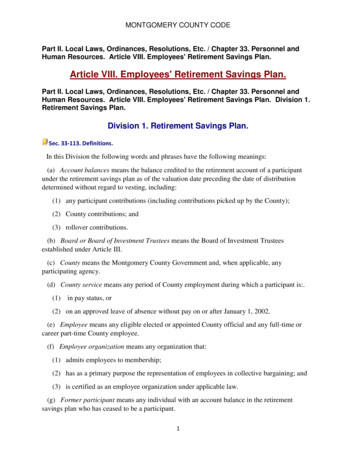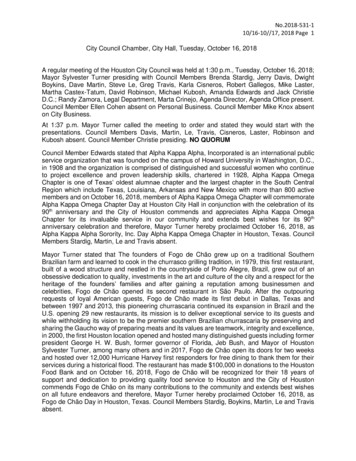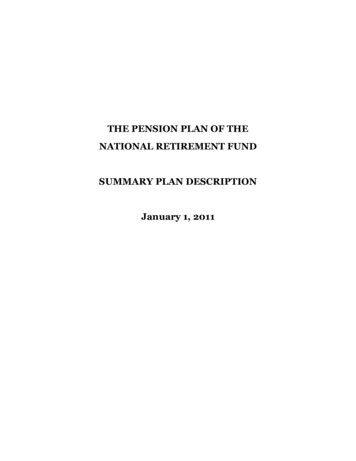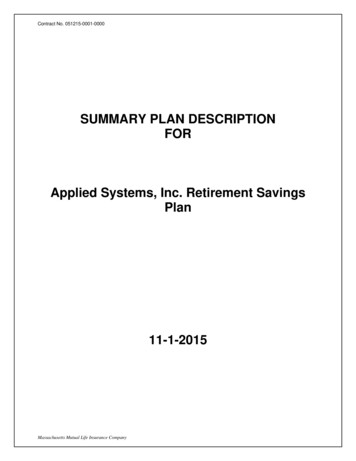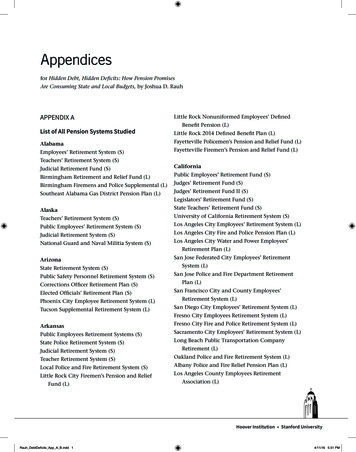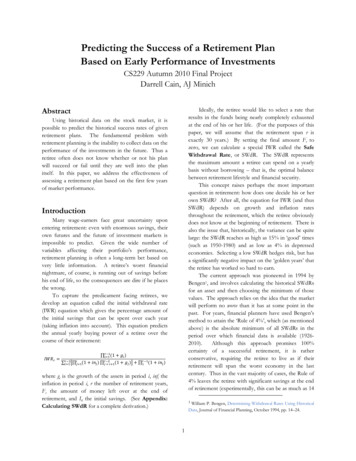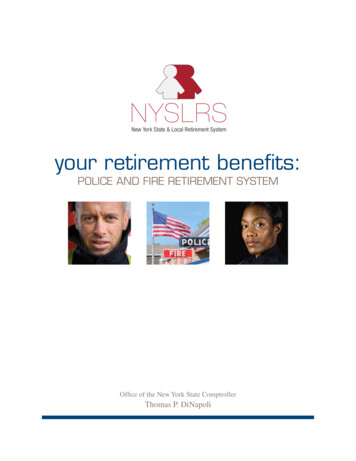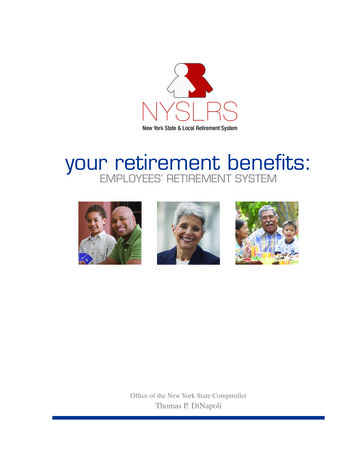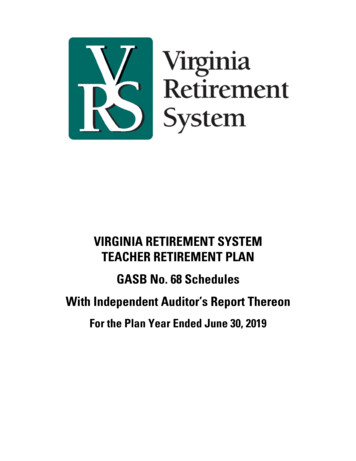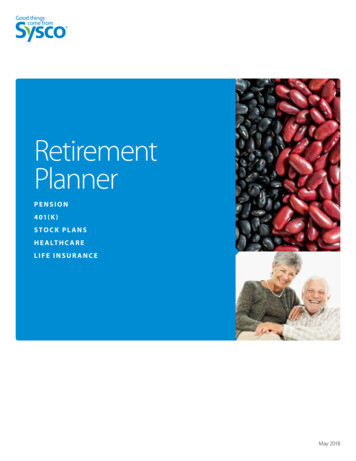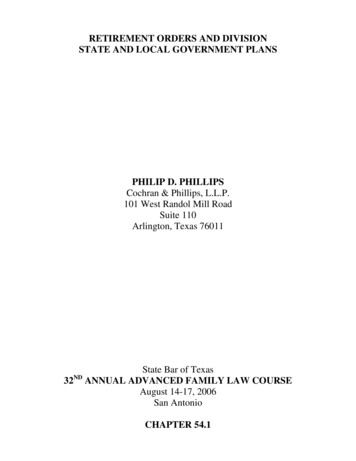
Transcription
RETIREMENT ORDERS AND DIVISIONSTATE AND LOCAL GOVERNMENT PLANSPHILIP D. PHILLIPSCochran & Phillips, L.L.P.101 West Randol Mill RoadSuite 110Arlington, Texas 7601132NDState Bar of TexasANNUAL ADVANCED FAMILY LAW COURSEAugust 14-17, 2006San AntonioCHAPTER 54.1
PHILIP D. PHILLIPSCochran & Phillips, L.L.P.101 W. Randol Mill Rd., Suite 110Arlington, Texas 76010(817) 795-6800Metro (817) 265-1077Fax (817) 795-6839Education:University of Texas at Austin (B.A. in Government, 1976)University of Houston Bates School of Law (J.D., 1979)Licensed:State of Texas - 1979U.S. District Court, Northern District of Texas - 1981Board Certification:Family Law - Texas Board of Legal Specialization (1984)Current Memberships:Member, State Bar of TexasMember, Family Law Section - State Bar of TexasMember, Texas Academy of Family Law SpecialistsMember, Tarrant County Bar AssociationPast-President / Director / Member, Tarrant County Family Law Bar AssociationProfessional Activities and Honors:President, Tarrant County Family Law Bar Association - 1995Grievance Committee Member & Dist. 7A-2 Panel Chair - 1996 - 2001Chair, Mentor Program Committee, Tarrant County Bar Association - 1995 - 1997Board of Directors, Tarrant County Family Law Bar Association - 1990 – 1996, 2001- 2004Fee Dispute Committee, Tarrant County Bar Association - 1991 - 1995Board of Directors, West Texas Legal Services Corp. - 1986 - 1990Volunteer Court Master, 233rd, 231st, 324th, 325th, & 360th District CourtsTexas Super Lawyers – Family Law, Texas Monthly, 2003, 2004, 2005 & 2006Publications and C.L.E. Activities:Web Master, Tarrant County Family Law Bar Assoc. Web Site (www.tcflba.com), 2001 - presentEditor, Tarrant County Family Law Bar Newsletter, 1995 – 2000“A Practical Guide to the Grievance Process”, Arlington Bar Assoc., Aug. 14, 2002“QDROs: Shared Interest v. Separate Interest”, Tarrant County Bar Assoc. Bulletin, June 2001“Retirement Plans: What To Do When No QDRO Is Honored”, Advanced Family Law Course 2000, Aug. 21-24,2000, San Antonio, Texas“QDRO's: What You Need Before You Do the Order", Austin Bar Assoc. – Family Law Sect., Feb., 2000; Nuts &Bolts Fam. Law Sem., June 16-17, 2000, Ft. Worth, Tx"Special Problems for Divorcing Professionals & Valuation of Professional Practices" (Co-Author), 24th AnnualAdvanced Family Law Course, Aug. 17-20,1998, San Antonio, Texas"Practicing Family Law for Fun and Profit" (Co-Author), Marriage Dissolution Institute, May 8-9, 1997, Dallas, TX"Divorce and Protective Orders", Lawyer's Against Domestic Violence Seminar - Oct. 21, 1994, Fort Worth, Texas"Special Problems", Third Annual Family Law Seminar, State Bar of Texas & West Texas Legal Services Corp.Private Attorney Involvement Program - June 16, 1993, Fort Worth, TX"Calculating the Present Value of Retirement Benefits", Tarrant County Family Law Bar Seminar - May 16, 1991,Fort Worth, Texas"A Practical Guide for Receiving Direct Payment of Military Retirement Benefits", 51 Tex. Bar Journal 253 (1988)
Retirement Orders and Division State and Local Government PlansChapter 54.1TABLE OF CONTENTSI.INTRODUCTION. 1II.SILVER BULLETS . 1A. In General1B. Teacher Retirement System (TRS)1C. Employees Retirement System (ERS)1D. Texas County and District Retirement System (TCDRS)1E. Texas Municipal Retirement System (TMRS)1F. Judicial Retirement System – Plan I and Plan II (JRS-I and JRS-II)2G. Texas Emergency Services Retirement System (TESRS)2H. Other Local Government Defined Benefit Plans2I. Other Local Government Defined Contribution Plans2III. OVERVIEW OF THE SYSTEMS. 2A. General Provisions for all Systems21. ERISA Doesn’t Apply but a QDRO is Required. 22. Qualification of a Domestic Relations Order . 23. Making a Public Retirement System a Party . 24. Statutory Grounds for Rejection of a QDRO . 25. Decree Must Clearly State Awarded Portion. 3B. Employees Retirement System of Texas (ERS)31. System Administration . 32. Benefit Funding . 33. Benefit Options. 34. Benefit Calculation . 45. QDRO Form . 4C. Teacher Retirement System of Texas (TRS)41. System Administration . 42. Benefit Funding . 53. Benefit Options. 54. Benefit Calculation . 55. QDRO Form . 6D. Judicial Retirement System Plan I (JRS-I) and Judicial Retirement System Plan II (JRS-II)61. System Administration . 62. Membership . 73. Benefit Funding . 74. Benefit Options. 7a. JRS-I . 7b. JRS-II. 75. Benefit Calculation . 76. QDRO Form . 8E. Texas County and District Retirement System (TCDRS)81. System Administration . 82. Benefit Funding . 83. Benefit Options. 84. Benefit Calculation . 95. QDRO Form . 9a. Pre-approved Form . 9b. Lump-Sum Awards. 9c. Berry Formula Not Used. 9d. “Accumulated Contributions” verses “Credited Service” Formulas . 10e. Special Language for Retired Participant’s . 10i
Retirement Orders and Division State and Local Government Plansf.Chapter 54.1Buy-Out Language. 10F.Texas Municipal Retirement System (TMRS)101. System Administration . 102. Benefit Funding . 103. Benefit Options. 104. Benefit Calculation . 115. QDRO Form . 11a. Pre-approved Form . 11b. Lump-Sum Awards. 12c. Berry Formula Not Used. 12d. “Accumulated Contributions” verses “Credited Service” Formulas . 12e. Special Language for Retired Participant’s . 12f. Buy-Out Language. 12G. Texas Emergency Services Retirement System (TESRS)131. System Administration . 132. Benefit Funding . 133. Benefit Options. 134. Benefit Calculation . 135. QDRO Form . 13a. Pre-approved Form . 13b. Berry Formula Not Used. 13H. Other Local Defined Benefit and Defined Contribution Plans141. Defined Benefit Plans. 142. Defined Contribution Plans . 14IV. EFFECT OF THE NEW SECTION 3.007 DEFINITION OF THE COMMUNITY PROPERTY INTEREST . 15A. Summary of the New Law15B. Texas Municipal Retirement System and Texas County and District Retirement System15C. Teacher Retirement System of Texas and Employees Retirement System of Texas15D. Judicial Retirement System – Plan I and Plan II16E. Texas Emergency Services Retirement System16APPENDIX A . 17APPENDIX B . 18APPENDIX C . 21APPENDIX D . 23APPENDIX E . 24ii
Retirement Orders and Division State and Local Government PlansChapter 54.1B. Teacher Retirement System (TRS)RETIREMENTORDERSANDDIVISION STATE AND LOCALGOVERNMENT PLANS I.INTRODUCTIONThis article begins with “Silver Bullets”, whichare short, essential points to aid the attorney inunderstanding a public retirement plan, dividing theplan, drafting a QDRO and avoiding commonmalpractice traps. The “Silver Bullets” each have areference to the detailed sections that follow for a morecomplete explanation of each bullet and each System.An attempt is also made to discuss the impact ofSection 3.007, Texas Family Code, to the seven majorState “public retirement systems” (the “Systems”).All statutory citations in this article are to theTexas Government Code unless otherwise indicated.My suggestion is not to attempt to comprehend thesestatutes or the Systems’ rules without the aid of a glassor two of wine. As with tax lawyers and ERISAlawyers, the lawyers that helped draft the Systemstatutes and advise the System are simply not like therest of us. Don’t attempt to award an alternate payee a lumpsum dollar amount. Percentages only. (III.C.5.)An alternate payee is not able to “cash-out” his orher awarded portion at time of divorce. (III.C.3.)Except under limited circumstances, payments toan alternate payee may begin only when themember’s payments begin. (III.C.3.)The amount of contributions has little to do withthe actual present value of the plan benefits. Thisis a defined benefit plan. (III.C.4.)C. Employees Retirement System (ERS) Don’t attempt to award an alternate payee a lumpsum dollar amount. Percentages only. (III.B.5.)An alternate payee is not able to “cash-out” his orher awarded portion at time of divorce. (III.B.3.)The amount of contributions has little to do withthe actual present value of the plan benefits. Thisis a defined benefit plan. (III.B.4.)Payments to an alternate payee may begin onlywhen the member’s payments begin. (III.B.3.)II. SILVER BULLETSA. In GeneralD. Texas County and District Retirement System(TCDRS) Don’t attempt to make a public retirement systema party to the divorce. It’s not necessary and willcost you or your client attorney fees and costs.(III.A.3.)A public retirement system may reject a QDROthat requires the designation of a particular personas beneficiary in the event of the member’s death.(III.A.4.)A public retirement system may reject a QDROthat requires the member to select a particularbenefit payment plan or option. (III.A.4.)All public retirement systems have a model orapproved form QDRO. Use it and resist makingsubstantial changes!!! (III.A.4.)All but one of the following public retirementsystems plans require member contributions.Upon retirement, a member may choose towithdraw his or her contributions with interest orreceive monthly annuity payments. In someplans, a member may be able to take a partiallump-sum distribution and a reduced monthlyannuity payment. (III.A.4.)If there is creditable service prior to marriage,clearly state in the Decree whether the division isof the entire benefit to date of divorce or only thecommunity portion. (III.A.5.) E.Texas Municipal Retirement System (TMRS) Lump-sum awards to an alternate payee areacceptable, providing the correct language isincluded in the QDRO. However, this doesn’tnecessarily mean that a lump-sum will actually bedistributed and there is no immediate paymentupon divorce. (III.F.3. & III.F.5.b.)A QDRO can use either the “AccumulatedContributions Formula” or the “Credited ServiceFormula” method with different benefit results.Make certain the correct one is used consideringthe circumstances. (III.F.5.d.) 1Lump-sum awards to an alternate payee areacceptable, providing the correct language isincluded in the QDRO. However, this doesn’tnecessarily mean that a lump-sum will actually bedistributed and there is no immediate paymentupon divorce. (III.E.3. & III.E.5.b.)A QDRO can use either the “AccumulatedContributions Formula” or the “Credited ServiceFormula” method with different benefit results.Make certain the correct one is used consideringthe circumstances. (III.E.5.d.)Payments to an alternate payee may begin onlywhen the member’s payments begin. (III.E.3.)
Retirement Orders and Division State and Local Government Plans Payments to an alternate payee may begin onlywhen the member’s payments begin. (III.F.3.)F.Judicial Retirement System – Plan I and PlanII (JRS-I and JRS-II) The statutory authority for the seven Systems iscontained in the Texas Government Code, Title 8, asfollows:Employees Retirement System of TexasSubtitle B. Chapters 811 - 820Teacher Retirement System of TexasSubtitle C. Chapters 821 - 830Judicial Retirement System of Texas Plan OneSubtitle D. Chapters 831 - 835Judicial Retirement System of Texas Plan TwoSubtitle E. Chapters 836 - 840Texas County and District Retirement SystemSubtitle F. Chapters 841 - 850Texas Municipal Retirement SystemSubtitle G. Chapters 851 - 860Texas Emergency Services Retirement SystemSubtitle H. Chapters 861 - 870Don’t attempt to award an alternate payee a lumpsum dollar amount. Percentages only. (III.D.5.)An alternate payee is not able to “cash-out” his orher awarded portion at time of divorce. (III.D.3.)The amount of contributions has little to do withthe actual present value of the plan benefits. Thisis a defined benefit plan. (III.D.4.)Payments to an alternate payee may begin onlywhen the member’s payments begin. (III.D.3.)G. Texas Emergency Services Retirement System(TESRS) This is the only State public retirement systemthat does not have employee contributions,participation by the department is optional and thelevel of participation can vary widely fromdepartment to department. (III.G.2.)An alternate payee is not able to “cash-out” his orher awarded portion at time of divorce. (III.G.3.)Payments to an alternate payee may begin onlywhen the member’s payments begin. (III.G.3.)Additionally, Subtitle A, Chapters 801 - 810, containprovisions generally applicable to all public retirementsystems.A. General Provisions for all Systems1. ERISA Doesn’t Apply but a QDRO is RequiredState public retirement systems are specificallyexcluded from the provisions of ERISA. However,Chapter 804, Subchapter A, provides anti-alienationprovisions to these public retirement systems similar toERISA and allows assignment of a benefit to analternate only by way of a qualified domestic relationsorder. (Sect. 804.003(a)).H. Other Local Government Defined BenefitPlans Although most city and local government definedbenefit plans permit division by court order andwill make direct payments, confirm that fact foryourself as early in the case as possible. (III.H.1.)I.Other Local Government Defined ContributionPlans Many city and local government definedcontribution plans will not permit division bycourt order, so resolve that question as early in thecase as possible. (III.H.2.)Chapter 54.12.Qualification of a Domestic Relations OrderThe administrative head of a public retirementsystem or his/her designee has exclusive authority todetermine whether a domestic relations order is a“qualified domestic relations order”.Such adetermination may only be appealed to the board oftrustees of the System. (Sect. 804.003(b)).3.Making a Public Retirement System a PartyA Court generally does not have jurisdiction overa public retirement system with respect to a divorce orother action in which an alternate payee’s right toreceive all or a portion of the System benefits iscreated or established. If a party attempts to make theSystem a party, that party shall be liable to the Systemfor its costs and attorney’s fees. (Sect. 804.003(c)). Atleast in the counties in which I practice, making a Planor System a party to a divorce simply isn’t done byattorneys any longer.III. OVERVIEW OF THE SYSTEMSThe seven State public retirement systems arestatutory creations. Although some of the Systemsdeny that they are defined benefit plans, for thepurposes of this article, I consider all of them as such.In addition to these seven Systems, a coveredemployee may be able to participate in a definedcontribution plan, such as a 457(b) or 401(k). Further,many of the larger cities have their own defined benefitplan, especially for police and fire fighters, separatefrom the seven public retirement plans.4.Statutory Grounds for Rejection of a QDROUnlike ERISA plan QDROs, being creative in thedrafting of a public retirement system QDRO rarely is2
Retirement Orders and Division State and Local Government PlansChapter 54.1is pre-marriage service and most trial courts beforewhich I have appeared interpret this language to dividethe entire benefit as of the date of divorce, if theDecree was agreed by the parties. Don’t get caught;state specifically what is being divided and on whatdate. One doesn’t have to use the convoluted languagecontained in the actual QDRO in the Decree but onemust still be concise.rewarded.Omitting or adding language to theSystem’s model QDRO will most likely result inrejection of the QDRO. Some attorneys feel compelledto tinker with all legal documents. In this instance,“Just Say No”. Section 804.003(g) provides eightsituations in which the System may reject the QDRO.The most common situations I see are (g)(2) and(g)(3), dealing with designation of a particular personas a beneficiary in the event of the employee’s deathand selection of a particular benefit payment form oroption, respectively.Public retirement systems, either by statute orrule, provide the manner in which System benefits areto be distributed in the event the employee dies prior tototal distribution. Neither the Court nor the partieshave the authority to change the statute or rule as tobeneficiaries, so such an attempt in the QDRO shouldbe avoided. Although it is common to designatebeneficiaries in ERISA plan QDROs, don’t do so withpublic retirement system orders.All the Systems, except for TESRS, allow aterminating or retiring member to make one of two,and sometimes three, elections in regards to the formor option of benefit payment. The member maychoose to (1) withdraw his/her contributions withinterest and cease participation in the System, (2)receive monthly annuity payments for his/her life, or(3) take a partial lump-sum payment with reducedmonthly annuity payments for his/her life. Option (3)is available in limited circumstances and only for someof the Systems. A QDRO will be rejected if it attemptsto require the member to select one of these options orforms of payment, or if the QDRO itself attempts tomake the election for the member.There are instances in which minor changes areacceptable and required. In the instance in which theparties agree on a date of division different from thedate of divorce, the words “date of divorce” in thedivision formula will have to be replaced with anactual date. So long as one is consistent throughout theOrder, the System will usually accept the change.B.1.Employees Retirement System of Texas (ERS)System AdministrationThis System is self-administered with a Board ofDirectors. Proposed QDROs and other contacts shouldbe directed to:Employees Retirement System of TexasCustomer Benefits DivisionP.O. Box 13207Austin, TX 78711-3207877-275-4377, ext. 7115 or 7776 (toll-free)512-867-7711, ext. 7115 or 7776 (Austinarea)www.ers.state.tx.us2.Benefit FundingERS is a defined benefit plan, but its membersmake contributions to the System by incomededuction. Currently, beginning on the first of themonth following the 90th day as an employee, 6% ofthe member’s monthly pre-tax salary is deducted andplaced into the member’s personal retirement account.This account earns 5% interest annually. Additionally,the State of Texas contributes 6.45% of the member’ssalary into a general fund.3.Benefit OptionsUpon termination or retirement, a member mustchoose one of three benefit options; (1) a refund of themember’s contributions with interest, (2) a monthlyannuity, or (3) a partial lump-sum with a permanentlyreduced monthly annuity. If a refund is elected, it ispaid as soon as it can be processed and the memberreceives no other System benefits in the future. Themember receives none of the State’s contributions tothe general fund.If annuity payments are elected, the member mustmeet certain age and service requirements in order forbenefit payments to begin. Generally, the membermust be either (1) age 60 with at least 5 yearscreditable service, or (2) Rule of 80 with 5 yearscreditable service. The Rule of 80 is that one’s age inyears and months added to creditable service in yearsand months must add up to at least 80. The age andcreditable service requirement increases if the memberseeks to retire with an annuity and insurance (65 and10 years or Rule of 80 and 10 years). Service Credit5.Decree Must Clearly State Awarded PortionWe all recognize that a Court may only divide thecommunity portion of a retirement plan when divisionof the property is contested. However, the parties arefree to contractually agree to divide the separateproperty portion, if they so choose. In the event theSystem member has credited service or contributionsprior to the marriage, the Decree must be clear andspecific as to what is being divided. I see manyDecrees that simply state, “Wife is awarded 50% ofHusband’s T.R.S. benefits”. Most times, the partiesand attorneys intend that to mean 50% of only thecommunity portion, effective on the date of divorce.However, that is not what this provision states if there3
Retirement Orders and Division State and Local Government PlansChapter 54.1states that it will not accept the Family Law PracticeManual form without changes, so I wouldn’t use it.The Model Order form uses a formula to dividethe benefit according to the Berry formula, meaningthat it is divided as of date of divorce, not date ofretirement. Berry v Berry, 647 S.W.2d 945 (Tex.1983). The method of division is based upon time(Creditable Service), not contributions, with thenumerator of the formula being the number of monthsof Creditable Service between the date of marriage anddate of divorce and the denominator being the totalmonths of Creditable Service as of the date of divorce.This fraction is then multiplied times the benefit thatthe member would receive had the member beenentitled to a benefit at the date of divorce and finally,times the percentage awarded to the alternate payee.In a case in which all of the Creditable Servicewas during the marriage, I attempted to “simplify” theModel Order by eliminating the marital formula andsimply multiply the percentage awarded to the alternatepayee (50%) times the benefit the member wouldreceive had the member been entitled to a benefit at thedate of divorce. ERS rejected it for no logical reason,but it taught me to resist simplification and creativitywhen dealing with State bureaucracies.Although ERS maintains an individual accountcontaining the member’s contributions and interestwhich the member may withdraw in lieu of annuitybenefits upon termination or retirement, never awardan alternate payee a lump-sum dollar amount. TheSystem will reject a QDRO that contains a lump-sumamount since that only instructs the System in theevent the member elects a lump-sum distribution upontermination or retirement. If the member electsmonthly annuity payments instead, the System has noguidance from the QDRO as to the portion to be paidto the alternate payee. Although the Model Ordercould be modified by the System to account for lumpsum awards, as does TMRS and TCDRS, it has notdone so.can include unused sick and annual leave, and ServiceCredit can be purchased under certain requirements. Amember may choose between a standard annuity and 5different options with survivor benefits.Under certain conditions, a member may elect apartial lump-sum, consisting of up to 36 months of thestandard annuity amount. In addition, a monthlyannuity payment will be received by the member but itwill be permanently reduced because of the lump-sumpayment.A Court may not direct a member as to whichbenefit option to elect, nor may a QDRO make thatelection. The election is solely in the discretion of themember. A QDRO that makes such an election ordirects the member to make such an election wil
Chair, Mentor Program Committee, Tarrant County Bar Association - 1995 - 1997 Board of Directors, Tarrant County Family Law Bar Association - 1990 - 1996, 2001- 2004 Fee Dispute Committee, Tarrant County Bar Association - 1991 - 1995 Board of Directors, West Texas Legal Services Corp. - 1986 - 1990

